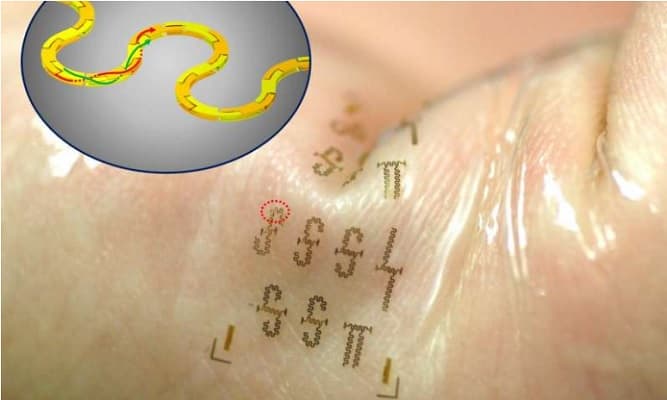Researchers Obtain New Ways To Make Fast And Stretchable Electronic Circuits
Electronic devices play a key role in our lives by providing means of connectivity and security. Whether they are our wearable smart devices or any health tracking system, they are present everywhere. Keeping in mind the importance of this technology, researchers have engineered a new technique to make stretchable circuits. It will not only help to revolutionize healthcare related devices, but also smart wearable technologies.

Strechable electronic circuits can be adhered to the skin as tattoos
A team of Engineers at the University of Wisconsin-Madison has created the world’s fastest stretchable-wearable integrated circuit that could help in making high speed wireless devices. Lynn H.Matthias, Vilas and Jack Ma –the brains behind this tech have published their work in the journal of Advanced Functional Materials on 27th of May, 2016 and are getting a good response from the scientific community for their remarkable contribution.

Jack Ma- one of the brains behind this tech
They are using high speed wireless 5G technology to make their circuits respond quickly. Furthermore, as most of the cell-phone and wearables are expected to advance to the 5G, it promises huge applications for the manufacture of fast responsive devices. The circuits operate in the frequency range between 0.3 GHz to 300 GHz which falls under the 5G range. It has been provided with two ultra-tiny repeating power transmission lines in the repeating s-curve. A shape like this, which is formed in two layers with segmented metal blocks provides stretching property to these circuits without affecting its performance. It also helps in shielding the circuit from outside interference and guiding the electromagnetic waves through it. The transmission lines used in these circuits are 0.25 mm thick and are highly effective for epidermal electronic systems.
They believe that these devices can help to design bio-medical instruments and monitoring systems which will operate wirelessly. It will not only help to monitor the patient’s health activities, but will also help in taking immediate measures during emergencies. It can also be used to design portable wearables and other IOT devices. They are now trying to enhance the applicability of the system by interfacing high frequency semiconductor devices. High frequency transistors have already been interfaced and further experiments could open a new door into the field of bio-medics and wearable technology.
Source- <a href="https://news.wisc.edu/fast-stretchy-circuits-could-yield-new-wave-of-wearable-electronics/" target="_blank" rel="nofollow noopener noreferrer">Fast, stretchy circuits could yield new wave of wearable electronics</a>

Strechable electronic circuits can be adhered to the skin as tattoos
A team of Engineers at the University of Wisconsin-Madison has created the world’s fastest stretchable-wearable integrated circuit that could help in making high speed wireless devices. Lynn H.Matthias, Vilas and Jack Ma –the brains behind this tech have published their work in the journal of Advanced Functional Materials on 27th of May, 2016 and are getting a good response from the scientific community for their remarkable contribution.

Jack Ma- one of the brains behind this tech
They are using high speed wireless 5G technology to make their circuits respond quickly. Furthermore, as most of the cell-phone and wearables are expected to advance to the 5G, it promises huge applications for the manufacture of fast responsive devices. The circuits operate in the frequency range between 0.3 GHz to 300 GHz which falls under the 5G range. It has been provided with two ultra-tiny repeating power transmission lines in the repeating s-curve. A shape like this, which is formed in two layers with segmented metal blocks provides stretching property to these circuits without affecting its performance. It also helps in shielding the circuit from outside interference and guiding the electromagnetic waves through it. The transmission lines used in these circuits are 0.25 mm thick and are highly effective for epidermal electronic systems.
They believe that these devices can help to design bio-medical instruments and monitoring systems which will operate wirelessly. It will not only help to monitor the patient’s health activities, but will also help in taking immediate measures during emergencies. It can also be used to design portable wearables and other IOT devices. They are now trying to enhance the applicability of the system by interfacing high frequency semiconductor devices. High frequency transistors have already been interfaced and further experiments could open a new door into the field of bio-medics and wearable technology.
Source- <a href="https://news.wisc.edu/fast-stretchy-circuits-could-yield-new-wave-of-wearable-electronics/" target="_blank" rel="nofollow noopener noreferrer">Fast, stretchy circuits could yield new wave of wearable electronics</a>
0
